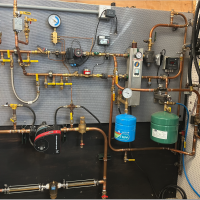ADVICE/IDEAS NEEDED! 3 Commercial Hot Water Heaters
First post here, but a long time lurker!
I have an 80 room hotel which I operate & I typically like to do my own research to develop ideas/plan prior to engaging a plumber given I’ve seen the ‘easy route’ taken far too often. I also enjoy putting my best effort forth to make informed decisions, ones which make sense in the long run!
With all said, I am in process of getting my entire hot water system at this hotel overhauled/updated. While doing this I’d like to focus on how to make improvements with respect to flow, efficiency & longevity. Most want to just replace the equipment but using the same infrastructure/layout.
I have attached a sketch of my Mech. Room along with photos to supplement the detail provided below.
I will be going from (3) Rheem GN100-200 tank heaters to (2) new Rheem GHE100SU-200 tank heaters & (1) Rheem GN100-200 tank heater (reusing 1 old one)
Questions:
1) How much sense it would make for me to increase the existing 1.5” pipes (from the hot/cold trunk lines to water heaters) to 2”? How much GPM & Pressure increase should I expect?
2) Based on how the recirculating pumps are plumbed, should the hot lines be plumbed in a ‘Reverse Return’ configuration? Basically First In/Last Out (FILO)? Currently the system is piped to be First In/First Out (FIFO) & we have been going through hot water heaters/tanks every 6 years. I am convinced the current setup could be contributing to the short lifespan of these heaters.
3) Should the 2 return lines with the recirc pumps on them be tied into a different area of this system, where it will be more productive/efficient or are they good how they are? Biggest thing I am stumped about here is how one of the return lines enter into the room at 1" size then goes down to 3/4" and right before it goes into the cold water loop, reduces again down to 1/2", should I just redo all the piping to be 1/2" up until the 1" line coming into the room? Or instead do the opposite by upgrading all the 3/4" & 1/2" line to 1" throughout on this return feed?
4) This is my first time seeing 2 return lines. Could someone tell me what “setup” I may have so I can research more on this?
Feel free to chime in with any questions or suggestions if you see something concerning!
Comments
-
Hi, Before doing any boiler room work, I'd be measuring shower flow rates and water pressures over at least a 24 hour period. If pressures fluctuate, I'd be looking at pressure compensating showerheads. Neoperl makes the innards for showerheads. I'd be installing 1.5 gpm heads if what you have now is larger. Once that work is done, I'd be metering hot water usage so yo know just what the demand really is. With that info, you can work in the boiler room and size the equipment to the measured need. You might find a lot of savings in equipment costs once the hot water demand is controlled. I know I'm not answering your questions directly, but this sequence of doing the work gives you the best chance of success.
Yours, Larry
5 -
@Larry Weingarten no pressure fluctuations and GPM’s have already been calculated.
To be clear, we have always had, at minimum, 2 (100 gallon) water heaters. Never ran out of hot water or issues with pressure.Only issue is that we can’t get them to last more than 6 years. While doing this changeout, I was wanting to make some changes/improvements to see how that fares us in respect to longevity, efficiency & overall use.
0 -
-
Hi, I'll stay at 30,000 feet for a bit with tank longevity… Things that kill tanks are pressure fluctuations, high pressure (I like to keep it around 40-60 psi), too much water thru-put, making the heater fire excessively, and overly conductive water (reducing the anode's useful life). You can add improper connections, like copper fitting to steel tank, but it's a smaller effect.
A reason I suggested low flow fixtures is to cut the time the heater/s are firing. A water quality report would be useful as well to get an idea of the conductivity of the water and to see if there are things in the water which could be damaging to tanks or plumbing, like manganese. Salt softening is another question. Softening done wrong can dramatically shorten useful anode life.
The elephant in this room is anodes. Have you replaced them regularly? I've gotten 40 years from commercial heaters by doing so. If you have not been doing that, any other measure is close to meaningless for tank longevity.
Yours, Larry
6 -
I always prefer tanks & boiler. The most tried and true I have ever found was the AO Smith HW 300, 420 or 670 boiler & 2 - 119 gals tanks If 2 100s have done ok for you in past. I get 20 to 30 years at least usually out of this set up. Problem is its standard 80% combustion efficiency so you give up some energy savings for reliability. You also may not be able to go std efficiency depending on your states energy codes. I have found nothing that compares for cost of ownership to the above setup. Larry I'm sure is right about checking water chemistry, changing anodes and flushing regularly to increase tank style gas water heaters life.
My .02 worth.
2 -
Water Test from 2024 Uploaded. Performed by EcoLab. Let me know if you see anything here! Appreciate all the help.
Our incoming water pressure floats between 40PSI-50PSI. Our main line coming into the building is 4" but once it hits the hot water heater room for cold water supply to the heaters, it reduces to down to 3".
0 -
you water is pretty hard, that will shorten tank life
What is the hot water demand in gpm, that is how you size the piping?
What temperature do you maintain?
Tankless water heaters are very common in hotels now, for efficiency and continuous dhw
If you go with a stainless tank or tankless you want to test for chlorides
Is there a laundry on property ?
Softening the hot water helps fixtures and soap consumption, also
Bob "hot rod" Rohr
trainer for Caleffi NA
Living the hydronic dream2 -
Hot Water Demand average is 35GPM. Peak is closer to 57GPM, so would like to at 60GPM or higher, just to be safe when running high occupancy.
140 degrees
Thought long & hard about tankless. Really wanted it, but got scared should one go out 3-5 years in and that same model be discontinued, risking the replacement not being any to communicate with the others in series. Maybe one day, but not right now.There is laundry on property, the 1.5” hot line shown in sketch uploaded bypasses the mixing valve loop and goes directly to this area.
I would like a softened on the entire water system, but two issues are:
- where my main feed comes in, I don’t have nearly enough space to put a proper system & have adequate space needed to service (average 3,500 gallons of water/day)
- A 4” head would kill the bank. Settling for just treating the hot side would let me get away with a 2” or 2.5” head. Much more manageable price. Will take something over nothing.
0
Categories
- All Categories
- 87.3K THE MAIN WALL
- 3.2K A-C, Heat Pumps & Refrigeration
- 61 Biomass
- 427 Carbon Monoxide Awareness
- 119 Chimneys & Flues
- 2.1K Domestic Hot Water
- 5.8K Gas Heating
- 114 Geothermal
- 165 Indoor-Air Quality
- 3.7K Oil Heating
- 76 Pipe Deterioration
- 1K Plumbing
- 6.5K Radiant Heating
- 395 Solar
- 15.6K Strictly Steam
- 3.4K Thermostats and Controls
- 56 Water Quality
- 51 Industry Classes
- 50 Job Opportunities
- 18 Recall Announcements






